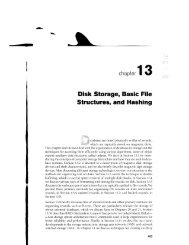this pdf excerpt
this pdf excerpt
this pdf excerpt
Create successful ePaper yourself
Turn your PDF publications into a flip-book with our unique Google optimized e-Paper software.
Chapter 3 Data Modeling Using the Entity-Relationship (ER) Model<br />
Figure 3.4<br />
A hierarchy of<br />
composite attributes.<br />
Address<br />
Street_address City State<br />
,,"1\ ,/l\<br />
./l\<br />
/\<br />
Number Street Apartment_number<br />
of values for the same entity-for example, a Colors attribute for a car, or .i<br />
College-degrees attribute fbr a person. Cars with one color have a single valr,rc.<br />
whereas two-tone cars have two color values. Similarly, one person may not have .r<br />
college degree, another person may have one, altd a third person rray have two or<br />
more degrees; therefore, different persons can have different ruunbers of values fctr<br />
the College_degrees attribute. Such attributes are called multivalued. A rnultivalued<br />
attribute may have lower and upper bounds to constrain the number of value:<br />
allowed for each individual entity. For example, the Colors attribute of a car may havc<br />
between one and three values, if we assume that a car can have three colors at most.<br />
Stored versus Derived Attributes. In some cases, two (or more) attribute values<br />
are related-fbr example, the Age and Birth-date attributes of a person. For a<br />
particular person entity, the value of Age can be determined from the current<br />
(today's) date and the value of that person's Birth-date. The Age attribute is hencc<br />
called a derived attribute and is said to be derivable from the Birth-date attribute.<br />
which is cailed a stored attribute. Some attribute values can be derived fronr<br />
related entities; for example, an attribute Number-of-employees of a DEPARTMENT<br />
entity can be derived by counting the number of employees related to (workins<br />
for) that department.<br />
NULL Values. In some cases, a particular entity may not have an applicable value<br />
for an attribute. For example, the Apartment-number attribute of an address applies<br />
only to addresses that are in apartment buildings and not to other types of residences,<br />
such as single-family homes. Similariy, a College-degrees attribute applies<br />
only to persons with college degrees. For such situations, a special value called N U LL<br />
is created. An address of a single-family home would have NULL for its<br />
Apartment-number attribute, and a person with no college degree would have NULL<br />
for College-degrees. NULL can also be used if we do not know the value of an attribute<br />
for a particuiar entity-for example, if we do not know the home phone number<br />
of 'John Smith'in Figure 3.3. The meaning of the former type of NULL is not<br />
applicable, whereas the meaning of the latter is unknown.The unknowfi category ot<br />
can be further classified into two cases. The first case arises rvhen it is known that














